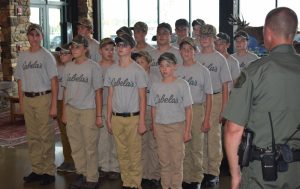
NEWARK – A full complement of 20 students concluded their week-long training at the Division of Fish & Wildlife Natural Resources Police’s inaugural Youth Academy with a recognition ceremony held at and hosted by Cabela’s at the Christiana Mall. As DNREC rolled out the law enforcement academy for the first time, students learned skills in boating, fishing and hunting as seen from both sides of an NRP officer’s badge. Ranging in age from 12 to 15, the students completed their Delaware boating and hunter education classes and received their boating and hunting education certificates at the concluding ceremony in front of family and friends.
Candidates were chosen to attend the academy staged July 18-22 based on their interests as well as their experience level – and their eagerness to gain relevant experience for perhaps one day joining the ranks of DNREC Fish & Wildlife Natural Resource Police. Each NRP Youth Academy applicant also had to submit a 500-word essay on why she or he wanted to attend. The academy offered free tuition for those selected to participate, with the majority of the training taking place at DNREC’s Ommelanden Hunter Education Training Center in New Castle.

In attending the week-long academy, students got exposed to the gamut of an NRP officer’s daily routine. They took part in patrol work as Fish & Wildlife Natural Resources Police officers by completing field scenarios that included checking deer stands and duck blinds; using a decoy deer to nab poachers in the act, and by making contact with visitors to Delaware’s wildlife areas managed by the Division of Fish & Wildlife. They also were given instruction in the safe operation of vessels, as well as learning about on-the-water enforcement activities. Throughout the academy, instructors emphasized the guiding principles of law enforcement, which included honor, respect, discipline, positive attitude, team work, leadership and commitment.
“The goal for the academy was to open the outdoor world to 20 young people, to expose them to boating, fishing and hunting and to share with them who we are and what it means to be a Fish & Wildlife Natural Resources Police officer,” said Captain Drew Aydelotte, Fish & Wildlife Natural Resources Police and acting NRP chief during the Youth Academy. “This group of young people represents the next generation of ethical outdoorsmen and women – and hopefully future officers who will join our elite unit.”
The 20 enrollees who completed the academy were: Johnathan Adkins of Dover; Ross Alexander Jr. of Bear; Alistair Bebbington of Newark; Benjamin Burris of Lothian, Md.; Troy Christiansen of Dover; Joshua Dyer of Dover; Haley Erickson of Clayton; Joseph Harwell of Newark; Ethan Hines of Townsend; Logan Koenig of Dover; Noah Kracyla of Townsend; Connor McDerby of Newark; Joseph McDermott of Townsend; Easley Pierson of Smyrna; Alexander Poore of New Castle; Luke Poore of New Castle; Anthony Puleo of Newark; William Shahan of Newark; Trevor Smith of Middletown, and James Williams of Marydel.
Awards were presented at the academy’s concluding ceremony to students who showed exceptional leadership, teamwork, sharpshooting, archery skills and fishing skills. William Shahan received the leadership award; James Williams was cited for teamwork; Easley Pierson was recognized for sharpshooting; Joseph Mcdermott excelled at archery; and Trevor Smith’s fishing skills all were lauded by NRP instructors.
The Division of Fish & Wildlife Natural Resources Police also thank the following sponsors who helped make the inaugural youth academy possible:
- Cabela’s
- Delaware Chapter of Ducks Unlimited
- Custom Improvers, Inc.
- Pat’s Salon in Townsend
- Chick-fil-a Middletown
- Delaware City Valero
- PSC Contracting, Inc.
- Pat’s Pizzeria in Delaware City
- La Matesina Pizza in Townsend
To learn more about the Division of Fish & Wildlife’s Natural Resources Police and its Youth Academy, please visit the law enforcement agency’s Facebook and Twitter pages at https://www.facebook.com/DEFWNRPolice/ and https://twitter.com/DE_FW_NRPolice, or the Fish & Wildlife Natural Resources Police homepage on the DNREC website at http://www.dnrec.delaware.gov/fw/Pages/Enforcement.aspx
Media Contacts: Sgt. John McDerby, Division of Fish & Wildlife Natural Resources Police, 302-739-9913 or 302-354-1386, or Joanna Wilson, DNREC Public Affairs, 302-739-9902
Vol. 46, No. 278